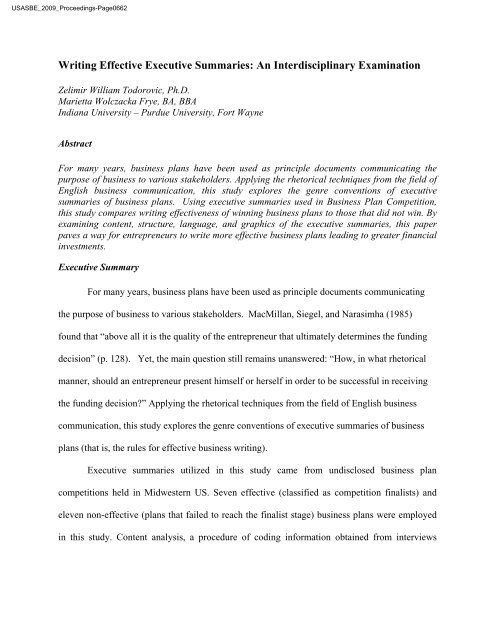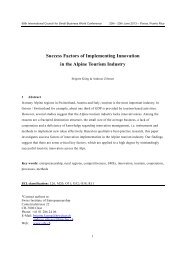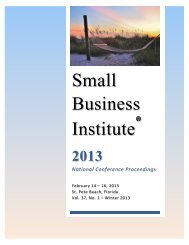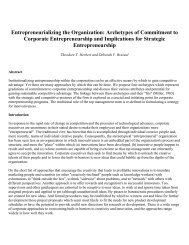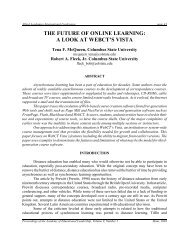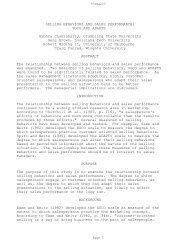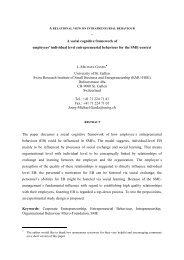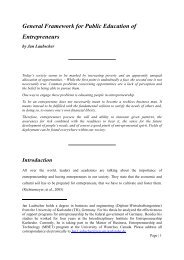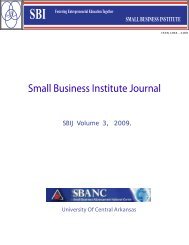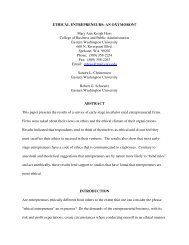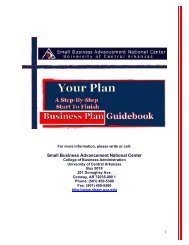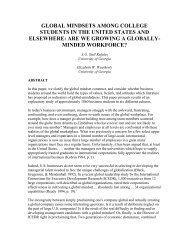Writing Effective Executive Summaries - Small Business ...
Writing Effective Executive Summaries - Small Business ...
Writing Effective Executive Summaries - Small Business ...
Create successful ePaper yourself
Turn your PDF publications into a flip-book with our unique Google optimized e-Paper software.
USASBE_2009_Proceedings-Page0662<br />
<strong>Writing</strong> <strong>Effective</strong> <strong>Executive</strong> <strong>Summaries</strong>: An Interdisciplinary Examination<br />
Zelimir William Todorovic, Ph.D.<br />
Marietta Wolczacka Frye, BA, BBA<br />
Indiana University – Purdue University, Fort Wayne<br />
Abstract<br />
For many years, business plans have been used as principle documents communicating the<br />
purpose of business to various stakeholders. Applying the rhetorical techniques from the field of<br />
English business communication, this study explores the genre conventions of executive<br />
summaries of business plans. Using executive summaries used in <strong>Business</strong> Plan Competition,<br />
this study compares writing effectiveness of winning business plans to those that did not win. By<br />
examining content, structure, language, and graphics of the executive summaries, this paper<br />
paves a way for entrepreneurs to write more effective business plans leading to greater financial<br />
investments.<br />
<strong>Executive</strong> Summary<br />
For many years, business plans have been used as principle documents communicating<br />
the purpose of business to various stakeholders. MacMillan, Siegel, and Narasimha (1985)<br />
found that “above all it is the quality of the entrepreneur that ultimately determines the funding<br />
decision” (p. 128). Yet, the main question still remains unanswered: “How, in what rhetorical<br />
manner, should an entrepreneur present himself or herself in order to be successful in receiving<br />
the funding decision?” Applying the rhetorical techniques from the field of English business<br />
communication, this study explores the genre conventions of executive summaries of business<br />
plans (that is, the rules for effective business writing).<br />
<strong>Executive</strong> summaries utilized in this study came from undisclosed business plan<br />
competitions held in Midwestern US. Seven effective (classified as competition finalists) and<br />
eleven non-effective (plans that failed to reach the finalist stage) business plans were employed<br />
in this study. Content analysis, a procedure of coding information obtained from interviews
USASBE_2009_Proceedings-Page0663<br />
(Krippendorff, 1980; Schneider, 1992), was employed in this study. Once the coding is done,<br />
data was analyzed.<br />
This study provides evidence that there is a difference in writing styles and the written<br />
content between effective and ineffective business plan summaries. Specifically, this paper posits<br />
that effective business plan summaries are richer with appropriate information, while at the same<br />
time being shorter in length. The following characteristics were identified as significant<br />
differences between effective and ineffective business plans: (1) Explicit discussion of each<br />
component of the executive summary, (2) Clear description of the product or service, strategic<br />
plan, and market., (3) Strong support for any claims using outside sources, (4) Contains fewer<br />
pronoun shifts, (5) Did not use adjectives that provide opinions; if used, they were supported<br />
with explicit statements of quality, (6) Used Standard English , and (7) Contained clear figures<br />
and visuals which were titled explicitly.<br />
Introduction<br />
A business plan, one of the subgenres of business written discourse, is meant to<br />
communicate an entrepreneur’s idea to a financial firm. For an entrepreneur, a business plan’s<br />
main purpose is to obtain funding for his or her unique idea. For a financial firm, a business plan<br />
is used in “the deal screening stage of the venture capital process” (Hindle & Mainprize, 2006, p.<br />
8). Deal screening, as defined by Hindle (1997), is “the initial decision process by a venture<br />
capital firm where many entrepreneurial business plans are screened down to a few that are<br />
deemed to have high probability of success and warrant further due diligence” (as cited in Hindle<br />
& Mainprize, 2006, p. 8). While an entrepreneur might create and submit one business plan,<br />
experienced venture capitalists evaluate, on average, 100 plans a month, from which only one to<br />
three are chosen for the investment (Timmons, 1994 as cited in Diaz de Leo & Guild, 2003, p.
USASBE_2009_Proceedings-Page0664<br />
139). How do venture capitalists approach this evaluating process?, What do they look for in a<br />
business plan?, and What criteria do they use for their evaluations? were some of the questions<br />
that rose at the outset of this study.<br />
While a business plan is the most important document for an entrepreneur looking for<br />
funding for his or her idea, an executive summary is deemed by a number of experts “the most<br />
important part of this most important document” (Adams, 1991; Harmon, 2002; Sant, 2004).<br />
Like an effective résumé’s submission invites a potential employee for an interview, an<br />
executive summary submitted on its own has the power to determine whether or not the<br />
submission of a complete business plan will be requested by venture capitalists. When a<br />
business plan accompanies the submission of an executive summary, it is the executive summary<br />
that is read first to determine whether or not venture capitalists will proceed with reading the<br />
plan in its entirety (Harmon, 2002, p. 35). In a recent study, Lagerwerf and Bossers (2002)<br />
observed and analyzed readers' preferences and reading behavior of executive summaries. Their<br />
findings revealed that most readers (89.5 percent and 76.9 percent in two separate studies)<br />
“started their selection paths with the management summary” (p. 448).<br />
Some experts go even further in recognizing the impact of the executive summary and<br />
claim that it is often the only part of a business plan that venture capitalists will read (Sant, 2004;<br />
Vassallo, 2003). Furthermore, Fulscher (1996) argues that a business plan itself is “just support<br />
material to the executive summary” (p. 64). Not all researches are as enthused about an<br />
executive summary’s importance. Keller (1994), for instance, believes that “the impact of an<br />
executive summary can be over-dramatized” and continues by arguing that “a good executive<br />
summary can’t cure a bad proposal” (p. 511). Yet, Keller recognizes the fact that an executive
USASBE_2009_Proceedings-Page0665<br />
summary is read by a high number of readers and does not recommend submitting a business<br />
plan without an executive summary (p. 511).<br />
Current business data indicates that more plans are rejected than accepted (Asner, 1991,<br />
p. 1). Furthermore, Asner argues “that price is rarely the only consideration and, many times, not<br />
even the main one” (p. 1). Keeping this argument in mind and accepting the above presented<br />
knowledge about the importance of executive summaries, this study analyzes executive<br />
summaries from a perspective of business writing genre in order to evaluate which rhetorical<br />
components of an executive summary contribute to its acceptance or rejection.<br />
Haselkorn (1985) argues that “business and technical writing textbooks are filed with<br />
advice about how to write proposals. But most of this advice is untested, based on the author’s<br />
personal experience and knowledge” (as cited in McIsaac & Aschauer, 1990, p. 527-528). Years<br />
later, Hindle (1997) further claims that “the vast majority of the abundant literature on ‘how to<br />
write a successful business plan’ is not research-based” (as cited in Hindle & Mainprize, 2006, p.<br />
7). In response to the limited research existing in the area, this study aims to contribute to a<br />
better understanding of an entrepreneur’s rhetorical choices and their impact on effectiveness of<br />
executive summaries.<br />
The paper is organized in the following manner: first, a review of a business plan<br />
literature is presented in order to emphasize a need for an in-depth research of executive<br />
summaries and a gap existing in this area of knowledge; second, an extensive discussion of genre<br />
conventions of the executive summary is presented; third, methodology for the current study is<br />
discussed; fourth, the findings and discussion from the current study are presented; and, finally,<br />
the study’s implications and limitations are mentioned.
USASBE_2009_Proceedings-Page0666<br />
Review of the Literature<br />
Over the last two decades, a cadre of business researchers has investigated the concept of<br />
a business plan in the context of entrepreneurs and their business ventures. Fry and Stoner<br />
(1985) reported in their study that these entrepreneurs regard effective planning, including<br />
writing business plans, “the most difficult function they have to perform” (p. 1). In spite of the<br />
fact that effective planning contributes to a venture’s success, planning still creates challenges to<br />
new entrepreneurs. Fry and Stoner attempted to help entrepreneurs overcome some of the<br />
planning challenges by explaining two types of plans; namely, working plans and investment<br />
plans (p. 2). Since Fry and Stoner were concerned with discussing differences between working<br />
and investment plans, consequently they hardly touched on examining the rhetoric of a business<br />
plan. Therefore, apart from learning about major distinctions between the aforementioned plans,<br />
entrepreneurs need to look for more in-depth advice on writing effective business plans in a<br />
different source.<br />
Information regarding the criteria used to evaluate new ventures is presented in a formal<br />
study conduced by MacMillan, Siegel, and Narasimha (1985). The researchers interviewed<br />
fourteen venture capitalists in the New York metropolitan area with a main purpose of<br />
establishing what criteria they use to evaluate new venture proposals (p. 120). A list of twentyseven<br />
evaluating criteria emerged from those interviews, and the criteria were classified into six<br />
major groups (for an in-depth presentation, see MacMillan, Siegel, and Narasimha, 1985). Not<br />
surprisingly, the main finding from this study confirms the well known statement that “above all<br />
it is the quality of the entrepreneur that ultimately determines the funding decision” (p. 128).<br />
Yet, the main question still remains unanswered: “How, in what rhetorical manner, should an
USASBE_2009_Proceedings-Page0667<br />
entrepreneur present himself or herself in order to be successful in receiving the funding<br />
decision?”<br />
Riquelme and Watson (2002) take the concept of venture capitalists evaluating criteria to<br />
a next level. Not only do they discuss what criteria venture capitalists use while evaluating new<br />
ventures, but they also conduct a study of venture capitalists in Great Britain in order to evaluate<br />
the validity of venture capitalists selection criteria. The study’s findings suggest that “the<br />
commonsense theories held by (their) sample of UK VCs have validity and, therefore, VCs<br />
should continue to look for new ventures that have a product with a competitive edge backed by<br />
a managerial team with appropriate experience” (p. 412). Although the presentations in the<br />
above two studies explicitly list venture capitalists evaluating criteria, they do not address the<br />
crucial ‘how’ an entrepreneur should structure and write his or her business plan to guarantee<br />
that it meets the expectations set by those criteria.<br />
In his discussion of executive summaries, Keller (1994) concentrates on a number of<br />
rhetorical markers that should guide an entrepreneur in writing this crucial document. Purpose,<br />
length, and content, along with other issues, are the center of this discussion. Even though<br />
Keller’s presentation explicitly focuses on each of the aforementioned issues, it neither provides<br />
an in-depth analysis of executive summaries nor examines the intended positive outcomes of<br />
creating and submitting for funding an executive summary that follows all the rules set in the<br />
presentation.<br />
An investigation of the correlation between planning and failure of the US small<br />
businesses was conducted by Perry (2001). The main finding from this study states that small<br />
US businesses engage themselves in very little planning, a state that contributes to their failures.<br />
Furthermore, successful businesses were found to do more planning “than similar failed firms
USASBE_2009_Proceedings-Page0668<br />
did prior to failure” (p. 201). Based on the findings, Perry’s main argument is that planning is<br />
“essential for business success” (p. 201). The findings from Perry’s study confirm Rue and<br />
Ibrahim’s (1998) findings regarding the importance of a written business plan - businesses<br />
without it exhibited a slower growth rate than businesses with a written plan. As important as<br />
Perry’s findings are, apart from listing five questions that need to be addressed in each business<br />
plan to enhance an entrepreneur’s chances of success, the presentation does not discuss the ‘how’<br />
to address these questions and what rhetorical manner needs to be used in order to further<br />
enhance the effectiveness of the plan.<br />
One of the recent studies by Cook, Belliveau, and Sandberg (2004) examines the process<br />
of creating business plans that took place as a part of a US macro enterprise training program.<br />
However apart from discussing the importance of feedback, components of panel review score,<br />
and writing a plan as a team versus writing it solo, the study does not provide any advice<br />
regarding the writing strategies that need to be employed while an entrepreneur writes the plan.<br />
From this study, an entrepreneur will learn that, in addition to working in a team, it is crucial to<br />
seek outside feedback on the plan before its submission, as both these aspects contribute to the<br />
plan’s effectiveness.<br />
Finally, Hindle and Mainprize (2006) conducted a literature review concerned with<br />
criteria used to evaluate written plans of new business ventures, and based on this review, they<br />
articulated 10 principles, titled the Entrepreneurial <strong>Business</strong> Plan Assessment Regime, which can<br />
serve as a guide for both writing and rating entrepreneurial business plans. However explicit in<br />
discussing the content of a business plan, the principles do not specify how this content needs to<br />
be presented in terms of rhetoric. Hindle and Mainprize (2006) conclude in their study, “The<br />
focus of future research should progress towards greater standardization of the writing and rating
USASBE_2009_Proceedings-Page0669<br />
of entrepreneurial business plans” (p. 21). Hence, the main purpose of the following sections<br />
will be to discuss genre conventions of business executive summaries in order to create a more<br />
standardized list of rhetorical components that contribute to the effectiveness of a written plan.<br />
Even though most of the components can be easily transferable and applicable to a business plan<br />
as a whole, the following genre discussion will focus primarily on conventions for writing an<br />
executive summary.<br />
Genre Conventions of <strong>Executive</strong> Summary<br />
A paucity of research exists that examines the rhetoric of executive summaries and its<br />
impact on the effectiveness of this document. Entrepreneurs aiming to write a business plan<br />
might search for advice in a number of periodicals that include “how-to” tips; however, these tips<br />
often do not have support in empirical research but come from data presented by individuals,<br />
venture capitalist, responsible for providing funding for new ventures. Moreover, as Riquelme<br />
and Watson (2002) point out, “in assessing new business proposals, venture capitalists rely on<br />
their own implicit theories (beliefs) about the attributes that a potentially successful business<br />
should possess” (p. 395). Diaz de Leo and Guild (2003) recognize the dangers associated with<br />
the assessment of intangibles in business plans by arguing that “when evaluating these<br />
investment opportunities, expert analysts frequently face approximate or soft data, often<br />
presented linguistically” (p. 136). Furthermore, they claim that an accurate method needs to be<br />
created in order to evaluate business plans more accurately (p. 136). The main purpose of this<br />
section is to discuss genre conventions for writing executive summaries in order to attempt to<br />
create an ‘accurate method’ that could be used for executive summaries evaluations and their<br />
writing process.
USASBE_2009_Proceedings-Page0670<br />
Genre<br />
Each and every written document is an example of a specific genre in a broad area of a<br />
written discourse. This document, as expected by its genre conventions, must exemplify certain<br />
conventions. Anne Beaufort (1999) defines these conventions by claiming that each recurring<br />
form must contain the following, most basic qualities of the document:<br />
1. Rhetorical features – components that address the audience’s expectations and<br />
needs in a particular way<br />
2. Content - components that facilitate addressing the audience’s expectations and answer<br />
their questions<br />
3. Structure - specific guidelines for organizing and presenting information<br />
4. Stylistic elements - appropriate language, use of jargon, formality (as cited in<br />
Clayton, 2002, p. 3).<br />
Therefore, as Rude (1995) points out, “genres trigger in readers assumptions about how a<br />
document should be used and the nature of knowledge within that document. Furthermore,<br />
genres steer readers’ approaches to interpretation and knowledge construction” (as cited in<br />
Suchan, 1998, p. 314).<br />
The above principles apply to business writing genre, and as<br />
Berkenkottenm and Huckin (1995) claim, “Professional readers have certain expectations of the<br />
documents they read. These expectations are based on genre conventions” (as cited in Lagerwerf<br />
& Bossers 2002, p. 437-438). Therefore, when an entrepreneur attempts to write a business plan,<br />
he or she needs to conform to the conventions set by a business discourse community and its<br />
genre.<br />
The following sections will discuss each component of an executive summary, as defined<br />
by its genre conventions; namely, purpose, length, content, structure, language, and graphics.
USASBE_2009_Proceedings-Page0671<br />
Purpose<br />
Consensus exists among researchers regarding the purpose of an executive summary for a<br />
business plan. The document is supposed to ‘highlight the most important and compelling<br />
aspects of the plan’ (Harmon, 2002), present these aspects in ‘a unique way, embodying high<br />
standards of literacy and numeracy’ (Hindle & Mainprize, 2006, p. 11), and ‘entice its readers to<br />
read on’ (Adams, 1991, p. 47) in order to request the submission of the lengthier formal business<br />
plan.<br />
Length<br />
Some researchers quote a specific number of pages for an executive summary, ‘no more<br />
than two pages, one if possible’ (Adams, 1991; Chang, 1995); ‘should not exceed three pages’<br />
(Fulscher, 1996; Harmon, 2002) while others, using percentage, state that an executive summary<br />
should ‘take up less than 10 percent of the entire document’ (Vassallo, 2003, p. 86). At this<br />
point, it is worth mentioning that busy venture capitalists, evaluating about one hundred plans a<br />
month, usually spend only five to ten minutes scanning the document before they decide whether<br />
or not to read it in its entirety (Schilit, 1987, p. 13).<br />
Content<br />
<strong>Business</strong> plans experts agree that poorly contextually structured proposals rarely get<br />
accepted (Asner, 1991; Rich & Gumpert, 1985; Schilit, 1987); however, what they are not in a<br />
definite agreement on are what components need to be included in an executive summary and<br />
what their placement in the document should be in order for this document to be deemed<br />
‘effective.’ Adams (1991) argues that conventions on the document structure of business reports<br />
demand that an executive summary include the following:
USASBE_2009_Proceedings-Page0672<br />
<br />
<br />
<br />
<br />
<br />
<br />
The primary purpose of the plan<br />
A sufficient definition of a business idea<br />
An overview of the market and market potential<br />
A summary of significant product features<br />
Financial history (if any)<br />
Financial requirements<br />
Long-term vision (p. 47).<br />
Rich and Gumpert (1985) claim that an executive summary should discuss “the company’s<br />
current status, its products or services, the benefits to customers, the financial forecasts, the<br />
venture’s objectives in three to seven years, the amount of financing needed, and how investors<br />
will benefit” (p. 162). The most explicit discussion of what components need to be included in<br />
an executive summary and its adequate placement in the document is presented by Schilit (1987,<br />
p. 15-16). Table 1 below presents six components of an executive summary and states what<br />
needs to be included in each component.<br />
----------------------------------------------------------------------<br />
Insert Table 1 about here<br />
----------------------------------------------------------------------<br />
Structure<br />
As Gilsdorf (2001) argues many “business readers tend to read rapidly, for meaning” (p.<br />
459); therefore, it is crucial that entrepreneurs facilitate this reading process by organizing an<br />
executive summary in an effective and easy to comprehend manner. A number of techniques<br />
have been claimed to be invaluable in such an endeavor; namely, effective paragraph<br />
organization, inclusion of headings and subheadings, incorporation of lists and bullets, and
USASBE_2009_Proceedings-Page0673<br />
supporting one’s claims with source citations. “Boldface type, headings, bulleted points, and<br />
white space will help you clarify your ideas. The more readable your proposal, the better your<br />
chances that the prospect will become a client,” argues Obuchowski (2005, p. 4).<br />
An executive summary’s text needs to broken down into clearly defined paragraphs.<br />
Each of these paragraphs should stand alone as a coherent, unified idea. In addition, an<br />
executive summary should be limited to a few paragraphs only (Vassallo, 2003, p. 88). To<br />
emphasize unified ideas standing on their own, headings and subheadings should be used. Both<br />
Aurner and Signband advocate use of headings and subheadings as aids for ‘fast and easy<br />
reading’ (as cited in de Villier, 1972, p. 15). To broadcast key points and reduce verbiage,<br />
entrepreneurs are advised to use bulleted lists (Clayton, 2003; Keller, 1994). Vassallo (2003)<br />
points out that “using bullets positions writers in a brevity-focused mindset. By placing key<br />
details into bullets, the writer keeps whittling away until every word counts and the ideas<br />
presented are conceptually parallel” (p. 90). Finally, in order to be credible, an entrepreneur has<br />
to “back up claims with case studies, research, or third-party recognition” (Wreden, 2002, p. 3).<br />
Language<br />
As Wreden (2002) emphasizes, “the most vital part of the process, of course, is writing.<br />
Proposals are often won or lost on the effectiveness of the writing” (p. 3). Kallendorf and<br />
Kallendorf (1985) add that “effective business prose makes its contribution to a company’s<br />
profitability by developing what we might call ‘assurance,’ or confidence in the company, its<br />
products, and its personnel” (p. 45). A few language rules for writing effective executive<br />
summaries have been identified, and they are presented in the discussion below.<br />
While linking words are known to guide readers and help them with understanding a<br />
written discourse, they are to be limited in business writing and especially in executive
USASBE_2009_Proceedings-Page0674<br />
summaries that should be written “to-the-point’ without too much context verbiage. Instead, an<br />
entrepreneur should concentrate all the efforts on including content words (Vassallo, 2003, p.<br />
89). <strong>Business</strong> experts reach a consensus regarding using technical vocabulary and acronyms;<br />
they all claim that technical vocabulary should be limited, and all the acronyms need to be<br />
spelled out the first time they are used (Asner, 1991; Fulscher, 1996; Harmon, 2002; Wreden,<br />
2002)<br />
The manner in which entrepreneurs refer to themselves have also been found to be a<br />
significant aspect attributing to a success, or lack of it, of a business document. Berleant (2000)<br />
reports that “using the term ‘we’ appears preferable to writing in the ‘I’ or the third person. Over<br />
half the proposals ranked as ‘Highly Competitive’ used ‘we,’ compared to less than half of the<br />
proposals in the ‘I’ and third-person categories” (p. 25). Pronoun ‘we,’ further argued by<br />
Jameson, “conveys that two people share a problem to be solved” (2004, p. 241).<br />
One of the language aspects that should have no place in executive summaries is an<br />
adjective that presents an unsupported opinion. These adjectives can be excised without any loss<br />
for the document (Weiss, 1978, p. 28). An entrepreneur needs to use concrete statements of<br />
quality rather than support his or her claims with adjectives that are highly subjective. As<br />
Fulscher (1996) argues, saying, ‘we have the best management company’ is meaningless.<br />
Instead, an explicit statement should be used; for example, ‘our property expenses are 14 percent<br />
below our competition’s’ (p. 64).<br />
Finally the most crucial law an entrepreneur needs to obey is writing in accordance with<br />
Standard English (SD) grammar. Grammatical errors bother readers because, as Shaughnessy<br />
(1977) says, “they are ‘unintentional and unprofitable intrusions upon the consciousness of the<br />
reader, … (demanding) energy without giving back any return in meaning (p.12)” (as cited in
USASBE_2009_Proceedings-Page0675<br />
Gilsdorf, 2001, p. 440). Proper writing, as further argues Gilsdorf, “has been equated to morality<br />
and virtue” (2001, p. 445).<br />
Visuals<br />
The last, but not the least, important component of executive summaries are visuals and<br />
graphics. Experts encourage entrepreneurs to include visuals in their documents in order to save<br />
space, clarify the meaning of more challenging concepts, and enhance audience’s understanding<br />
of a document (Keller, 1994; Fulscher, 1996; Wreden, 2002).<br />
Methodology<br />
There is little empirical basis available to guide our understanding towards writing<br />
effective business plan proposals. A quantitative (positivist) framework relies heavily on extant<br />
theory (Creswell, 1994, p. 88). Consequently, the theoretical implications of effective business<br />
plan writing must be well understood. Qualitative methods are often used to develop theory<br />
(Creswell, 1994, p. 88). The difficulty found with qualitative methodology, however, is that it<br />
does not lend itself very well to the quantitative manipulations needed for the quantitative<br />
methodology which may be used in subsequent studies (Schneider, 1992, p. 337). To circumvent<br />
this problem, the study employs content analysis methodology (Krippendorff, 1980 p. 348).<br />
Content analysis is a methodology that is positioned between quantitative and qualitative<br />
methods (Schneider, 1992, p. 337) and is understood as a procedure of coding information<br />
obtained from interviews (Krippendorff, 1980; Schneider, 1992). Once the coding is done, data<br />
is amenable to quantitative data manipulations (Schneider, 1992, p. 337). This process involves<br />
the development of coding themes for the statements made by the participants (Schneider, 1992,
USASBE_2009_Proceedings-Page0676<br />
p. 337). Schneider et al. (1992, p. 337) find that content analysis provides results that can be<br />
utilized in quantitative data manipulations and may be useful for latter studies.<br />
<strong>Executive</strong> summaries utilized in this study came from undisclosed business plan<br />
competitions held in Midwestern US. Seven effective and eleven non-effective business plans<br />
were employed in this study. <strong>Effective</strong> business plans were defined as a business plans that were<br />
classified as competition finalists. Competitions were judged by a panel of community based<br />
judges, mostly consisting of practicing (or former) entrepreneurs and venture capitalists. Noneffective<br />
business plans, on the other hand, were defined as plans that failed to reach the finalist<br />
stage in these competitions. For consistency of criteria, only one competition (over a three year<br />
period) was used, ensuring that effective and non-effective business plans were in direct<br />
competitions with each other.<br />
In a number of criterion that required a judgment call, inter-rater approach was utilized to<br />
ensure the minimization of a personal bias that may be present with the investigator. For<br />
example, an evaluation of the clarity of visual presentation, which employed a 5-point Likart<br />
scale, was established by an average of the evaluation done by the MBA graduate, a journalist,<br />
and present investigators.<br />
Findings and Discussion<br />
Content analysis methodology represents an effort to establish whether business plan<br />
content plays a role, and more importantly, which aspects of the analysis are the most crucial.<br />
Tables 2 to 6 present summarized results of content analysis of successful as well as<br />
unsuccessful business plans. Table 2 presents business description, strategic direction and market<br />
description, while Table 3 looks at the management descriptivism, financial features and exit<br />
strategy discussions. Building upon the research from the field of English, Table 4 considers the
USASBE_2009_Proceedings-Page0677<br />
organization of the paper, and Table 5 looks at the language. Finally, Table 6 looks at the visuals<br />
present in the business plan summaries.<br />
Written Content<br />
Written content analysis includes the description of business (description of<br />
product/service its features and future goals), discussion of strategic direction (including strategic<br />
plan and its implementation) and the presentation of market conditions (including the<br />
identification of the target market and the market channels). When analyzing the data from<br />
presenting ‘description of business,’ (Table 1) it is evident that in general the effective executive<br />
summaries are more successful than the non-effective summaries in defining their proposed<br />
initiatives. While all of the effective summaries provided the ‘product/service description’ and<br />
defined its ‘features,’ three out of 11 non-effective summaries did not discuss the product/service<br />
at all or did not sufficiently describe the features. The difference between the summaries is more<br />
explicit when the discussion of ‘future goals’ is analyzed; only four out of eleven non-effective<br />
summaries concentrated on discussing ‘future goals’ while all but one effective summaries<br />
provided such a discussion.<br />
----------------------------------------------------------------------<br />
Insert Table 2 about here<br />
----------------------------------------------------------------------<br />
Likewise, some difference is also observed in terms of ‘strategic direction’ have been<br />
identified. The findings suggest that the effective summaries have a higher understanding of their<br />
strategic direction (all of the effective summaries include its discussion) than the non-effective<br />
summaries (three out of eleven summaries have no mention of their strategic direction). It<br />
appears that venture capitalist and other audiences are made more comfortable if the business<br />
plan shows awareness of the strategic issues and concepts.
USASBE_2009_Proceedings-Page0678<br />
A similar scenario is apparent when ‘market’ is analyzed. Even though there is no<br />
overall significance between its presentation by the effective and non-effective executive<br />
summaries, a crucial difference exists when ‘market channel identification’ is presented. Only<br />
two out of seven effective summaries do not discuss how they are planning to reach their defined<br />
markets while more than 85 percent, six out of seven to be precise, of the non-effective<br />
summaries does not include this discussion in the document.<br />
Management Aspects<br />
Management aspects include the discussion of management (discussion of management<br />
team backgrounds and responsibilities), financials (projected sales, profits, capital requirements),<br />
and exit strategies. In examining Table 3, a strong significance is observed while comparing the<br />
presentation of ‘management responsibilities’ in the documents. While three out of seven<br />
effective summaries discuss management responsibilities, only two out of eleven executive<br />
summaries include this crucial aspect in their discussion. Data from ‘financial features’ sections<br />
also demonstrate that the effective summaries exhibit an overall better understanding of this<br />
crucial concept, especially of the ‘capital needed’ and ‘proceeds usage’ subcomponents. While<br />
six out of seven effective summaries addressed both of these subcomponents, nine and six noneffective<br />
summaries, respectively, failed to address the same. Examining the ‘exit’ component,<br />
however, there are no significant differences between the summaries. A finding worth<br />
mentioning is the fact that both the effective and non-effective summaries hardly at all discuss<br />
this component.<br />
----------------------------------------------------------------------<br />
Insert Table 3 about here<br />
----------------------------------------------------------------------
USASBE_2009_Proceedings-Page0679<br />
Structure<br />
Table 4 shows the results of the structure analysis. Structure analysis refers to the<br />
characteristics of the papers such as number of pages, words, paragraphs, and the average<br />
number of sentences per paragraph. Structure also includes the number of headings and<br />
subheadings, the presence of lists & bullets, as well as the presence of source citations. A couple<br />
aspects need mentioning when analyzing the structure of the executive summaries. Overall, the<br />
effective summaries consist of fewer words (with an average of 832 words per summary) than<br />
the non-effective ones (with an average of 999 words per summary). These observations might<br />
suggest that the effective summaries are more concise, presenting all the necessary information<br />
using fewer words. It is interesting to point out, however, that the page length of the summaries<br />
appears not to support the above observations. While on average the effective summaries have<br />
2.2 pages, the non-effective summaries have 2.4 pages. The difference does not appear as<br />
significant as the same discrepancy in the word count. This can be easily attributed to the<br />
presence, or its lack, of visuals in the documents. (Visuals’ discussion is presented below.)<br />
Another characteristic that seems to play a crucial role in the executive summary’s<br />
effectiveness is the use of citations and supporting one’s claims with outside sources. While five<br />
effective summaries incorporated this characteristic in their documents, nine out of eleven noneffective<br />
summaries did not do so. (Please refer to Appendix B for detailed findings regarding<br />
the organization evaluations.)<br />
----------------------------------------------------------------------<br />
Insert Table 4 about here<br />
----------------------------------------------------------------------
USASBE_2009_Proceedings-Page0680<br />
Language<br />
Language refers to the number of linking words, of undefined acronyms, of pronoun<br />
"we" and “I” uses. It also includes the occurrence of technical jargon, third person pronoun uses,<br />
opinion adjectives, and grammatical/mechanical errors. Language analysis of the summaries<br />
reveals interesting findings in respect to the use of linking words, pronouns, adjectives, and<br />
Standard English. The non-effective summaries used more linking words than did the effective<br />
summaries, 4.9 and 2.7 respectively. A couple of possible conclusions can be made in an<br />
attempt to understand this finding. Since the non-effective summaries are longer on average, it<br />
can be argued that they will consequently contain more linking words. A counterargument can<br />
be made which would suggest that the effective summaries are classified as more ‘to-the-point’<br />
than are the non-effective ones; hence, they use fewer linking words. This second conclusion<br />
appears more consistent with other findings of this study.<br />
Analysis of pronouns usage shows that pronoun shifts are more common in the noneffective<br />
summaries. The non-effective summaries shift between the first person plural and the<br />
third person singular much more often than do the effective summaries. On average, the<br />
effective summaries use only 2.2 pronouns in the first person plural and 12.4 pronouns in the<br />
third person singular. Non-effective summaries, on the other hand, use 9.7 and 16.3 pronouns<br />
respectively, creating a more frequent pronoun shift. Such a shift makes the text harder to<br />
comprehend, as a reader might get confused as far as who a subject, a performer of an action, is.<br />
A significant difference exists in the use of adjectives that present an opinion without giving data<br />
to support the claim. For example, saying that sales are skyrocketing, without giving explicit<br />
numbers, is qualified as such an adjective presenting unsupported opinion. On average, the
USASBE_2009_Proceedings-Page0681<br />
effective summaries use 4.1 adjectives that contain an unsupported opinion, and the noneffective<br />
summaries use 7.8 of such adjectives.<br />
The most crucial difference is apparent when grammatical and mechanical errors are analyzed.<br />
While the effective summaries are written in a clear prose, mostly free of errors, and are<br />
employing Standard English rules, the non-effective ones are written in a prose that is at times<br />
unclear and filled with a number of destructive errors. On average, the effective executive<br />
summaries have five errors while the non-effective summaries have 15.8. In addition, the<br />
standard deviation for these errors is 2.6 and 12.2 respectively, suggesting that this is a<br />
significant difference between effective and non-effective summaries. This data confirms the<br />
claims set by a number of business experts that an executive summary, in order to be successful,<br />
needs to be written in a clear prose and follow Standard English rules (Gilsdorf, 2001; Asner,<br />
1991). (Please refer to Appendix C for detailed findings regarding the language evaluations.)<br />
----------------------------------------------------------------------<br />
Insert Table 5 about here<br />
----------------------------------------------------------------------<br />
Visuals<br />
Finally, the visuals refer to the presence, frequency and quality of visual aides used. This<br />
category also includes the existence of reference to the visuals in the prose of the summary itself.<br />
Based on this study’s data, an argument in support of using visuals can be made. All of the<br />
effective executive summaries included at least one visual, with an average of 2.2 visuals per<br />
summary. Four out of eleven non-effective summaries did not include any visuals, with an<br />
average of only 1.2 visuals per summary. In addition to the inclusion visuals, or the lack thereof<br />
being a variable, the quality of visuals’ presentation provided a significant difference.<br />
----------------------------------------------------------------------
USASBE_2009_Proceedings-Page0682<br />
Insert Table 6 about here<br />
----------------------------------------------------------------------<br />
Analyzing the visuals’ clarity, the following findings are of importance (on a scale from 5<br />
to 1 with 5 being the clearest and 1 being the least clear). On average the effective summaries’<br />
visuals received 4.1 for their clarity while the non-effective summaries’ visuals received 3.5 for<br />
their clarity. In addition, 81.2 percent of the visuals in the effective summaries were explicitly<br />
titled while only 8.3 percent of the visuals of the non-effective summaries were titled.<br />
Cumulative analysis<br />
In an attempt to further understand the above findings, Tables 2 to 6 were agglomerated<br />
into one table. In addition to the data extant in the tables, additional columns were added that<br />
calculate the change in frequency, average and standard deviation between the effective and noneffective<br />
summaries. The fields were then sorted based on the extent of difference between the<br />
effective and ineffective summaries.<br />
It is necessary to note that top 10 categories that are most differentiated between the<br />
effective and ineffective summaries are made up of five categories from language and three<br />
categories from organization sections. Remaining two categories come from visuals and<br />
management. However, even the visual category (“visuals titled”) may be more reflective of<br />
proper language usage than it is of the visual itself. On the other hand, four of the ten least<br />
differentiated items come from management category, with remaining three being from content,<br />
two from visuals and one from language.<br />
These observations suggest that, in our sample, language and organization played a most<br />
significant role in differentiating between the two types of summaries. It is posited that<br />
management and content categories are not any less significant, but most likely are already<br />
included and well presented in the majority of the summaries. This study suggests that future
USASBE_2009_Proceedings-Page0683<br />
teaching efforts by universities and colleges need to focus on supplementing the would be<br />
entrepreneurs with the skills and assets that they need or lack. This is intuitively appealing if one<br />
realizes that entrepreneurs tend to be focused on the product and process of the idea rather than<br />
the communication of the same to the financing community.<br />
Conclusions and Implications<br />
A few significant guidelines (presented below) emerge from this study, and these should<br />
be taken into a careful consideration by entrepreneurs who plan to prepare their “winning”<br />
executive summary. They could guide an entrepreneur in the process of writing as well as they<br />
could serve as a checklist during final revisions. In addition, revising the document a few times,<br />
each time concentrating on its different aspect, might be beneficial to its overall effectiveness.<br />
This study provides evidence that there is a difference in writing styles and the written<br />
content between effective and ineffective business plan summaries. Specifically, this paper posits<br />
that effective business plan summaries are richer with appropriate information, while at the same<br />
time being shorter in length. <strong>Effective</strong> summaries make use of written communication to<br />
demonstrate knowledge and awareness suggesting management capability and potential.<br />
While specific elements of these summaries have been identified, this study demonstrates<br />
a need for institutions of higher education to teach students more completely the craft of business<br />
plan preparation. Findings form this study support the assumption that business plan preparation<br />
training is focused more on the content element of business plan development, than on business<br />
plan delivery. It follows that such training programs, therefore, enjoy lower success rate than<br />
would otherwise be possible. Following are more specific recommendations and guidelines<br />
extracted from the results of this study.
USASBE_2009_Proceedings-Page0684<br />
<strong>Executive</strong> Summary Guidelines<br />
While writing and/or evaluating the content, make sure to:<br />
<br />
explicitly discuss each component of the executive summary (refer to the Schilit’s<br />
content mentioned above), and<br />
<br />
pay particular attention to describing the product or service, strategic plan, and market.<br />
While organizing and/or evaluating the structure of an executive summary, make sure to:<br />
<br />
<br />
write concisely by avoiding unnecessary verbiage, and<br />
support any claims with outside sources to enhance credibility.<br />
While writing and/or evaluating the language, make sure to:<br />
<br />
<br />
avoid pronoun shifts by being consistent with their usage,<br />
avoid using adjectives that provide opinions; if used, they have to be supported with<br />
explicit statements of quality,<br />
<br />
<br />
use Standard English, and<br />
avoid making grammatical and mechanical errors by proofreading extremely carefully.<br />
While preparing the document, include visuals and make sure to:<br />
<br />
<br />
evaluate their clarity, and<br />
title them explicitly.<br />
In the current competitive world, no business plan can guarantee success in obtaining<br />
funding for a new venture; however, keeping the above guidelines in mind and applying them to<br />
the writing process of an executive summary might enhance the chances of a positive outcome.<br />
To conclude, it is critical to emphasize that “proposals structured along the lines of genre<br />
conventions do enhance appreciation of business decision makers. (…) Professional readers who<br />
read a conventionally structured document capture more information than professional readers
USASBE_2009_Proceedings-Page0685<br />
who read the same document with another structure” (Lagerwerf & Bossers 2002, p. 450).<br />
Therefore, a careful analysis of the aforementioned genre conventions should only prove<br />
beneficial to an entrepreneur.<br />
Limitations<br />
As with all research, the present study included limitations, in particular, the number of<br />
samples for analysis. Having only seven effective executive summaries and eleven non-effective<br />
summaries provided a small sample for the current analysis; therefore, literal and strict<br />
applications should be made with constructive criticism. It would be interesting to examine<br />
whether or not similar results to the current study emerge when the sample size is relatively<br />
larger. This interest paves the way for future studies that could incorporate a larger sample of<br />
data.<br />
The competition structure could also be classified as one of the limitations. In the<br />
competitions, the judges were supposed to choose “five” executive summaries that they deemed<br />
effective. This number not only limited their choices (there could have been other executive<br />
summaries that were effective but did not get chosen) but also could contribute to them choosing<br />
executive summaries (to fulfill the specified number) that did not deserve the prize. Finally,<br />
future research could concentrate on analyzing executive summaries from various competitions<br />
in order to conduct a comparative study.<br />
Bibliography<br />
Adams, E. (1991). Building a better business plan. Home Office Computing, 9(5), 43-47.<br />
Asner, M. (1991). Creating a winning proposal. <strong>Business</strong> Quarterly, 56(3), 36-39.<br />
Berleant, D. (2000). Does typography affect proposal assessment? Communications of the ACM, 43(8),<br />
24-25.
USASBE_2009_Proceedings-Page0686<br />
Chang, M. (1995). Developing your business plan. Laser Focus World, 31(6), 61-64.<br />
Clayton, J. (2003). <strong>Writing</strong> and executive summary that means business. Harvard Management<br />
Communication Letter, 6(8), 3-4.<br />
Cook, R., Belliveau, P., & Sandberg, M.E. (2004). Training and Learning as Drivers of US<br />
Microenterprise <strong>Business</strong> Plan Quality. Education & Training 46, 398-405.<br />
Creswell, J. W. (1994) Research Design, Qualitative and Quantitative Approaches. 227 London: SAGE<br />
Publications.<br />
De Villier, J.L. (1972). Communication effects of variations in organization and format. Journal of<br />
<strong>Business</strong> Communication, 9(3), 5-18.<br />
Diaz de Leo, E. & Guild, P. (2003). Using repertory grid to identify intangibles in business plans. Venture<br />
Capital 5, 135-160.<br />
Fry, F. L. & Stoner, C. R. (1985). <strong>Business</strong> Plans: Two Major Types. Journal of <strong>Small</strong> <strong>Business</strong><br />
Management 23, 1-6.<br />
Fulscher, R. J. (1996). A no-fail recipe. Journal of Property Management, 61(1), 62-66.<br />
Gilsdorf, J. (2001). Big stuff, little stuff: A decennial measurement of executives’ and academics’<br />
reactions to questionable usage elements. Journal of <strong>Business</strong> Communication, 38(4), 439-475.<br />
Handle, K., & Mainprize, B. (2006). A systematic approach to writing and rating entrepreneurial business<br />
plans. The Journal of Private Equity, 9(3), 7-22.<br />
Harmon, R. (2002). How to write a business plan. njbiz, 15(40), 35.<br />
Jameson, D. (2004). Conceptualizing the Writer-Reader Relationship in <strong>Business</strong> Prose. Journal of<br />
<strong>Business</strong> Communication 41, 227-64.<br />
Kallendorf, C., & Kallendorf, C. (1985). The figures of speech, Ethos, and Aristotle: Notes towards a<br />
rhetoric of business communication. Journal of <strong>Business</strong> Communication, 22(1), 35-50.<br />
Keller, C. (1994). Stay healthy with a winning executive summary. Technical<br />
41(3), 511-17.<br />
Communication,<br />
Krippendorff, K. (1980). Content Analysis: An Introduction to its Methodology. Beverly Hills, CA:<br />
Sage.<br />
Lagerwerf, L. & Bossers, E. (2002). Assessing <strong>Business</strong> Proposals: Genre Conventions and Audience<br />
Response in Document Design. Journal of <strong>Business</strong> Communication 39, 437-60.<br />
MacMillan, I., Siegel, R., & Narasimha, P.N. S. (1985). Criteria used by venture capitalists to evaluate<br />
new venture proposals. Journal of <strong>Business</strong> Venturing, 1(1), 119-128.<br />
McIsaas, C.M., & Aschauer, M.A. (1990). Proposal writing at Atherton Jordan, INC. Management<br />
Communication Quarterly, 3(4), 527-560.
USASBE_2009_Proceedings-Page0687<br />
Obuchowski, J. (2005). Persuasive business proposals: <strong>Writing</strong> to win more customers,<br />
contracts. Harvard Management Communication Letter, 2(3), 3-4.<br />
clients, and<br />
Perry, S. (2001). The Relationship between Written <strong>Business</strong> Plans and the Failure of <strong>Small</strong> <strong>Business</strong>es in<br />
the U.S. Journal of <strong>Small</strong> <strong>Business</strong> Management 39, 201-8.<br />
Rich, S.R., & Gumpert, D.E. (1985). How to write a winning business plan. Harvard <strong>Business</strong> Review,<br />
63(3), 156-163.<br />
Riquelme, H. & Watson, J. (2002). Do venture capitalists’ implicit theories on new business<br />
success/failure have empirical validity? International <strong>Small</strong> <strong>Business</strong> Journal, 20(40), 395-420.<br />
Rock, A. (1987). Strategy vs. tactics from a venture capitalist. Harvard <strong>Business</strong> Review, 65(6), 63-67.<br />
Rue, L.W. & Ibrahim, N.A. (1998). The Relationship between Planning Sophistication and Performance<br />
in <strong>Small</strong> <strong>Business</strong>es. Journal of <strong>Small</strong> <strong>Business</strong> Management, 36(4), 24-32.<br />
Sant, T. (2004). Persuasive <strong>Business</strong> Proposals: <strong>Writing</strong> to Win More Customers, Clients, and Contracts.<br />
New York: AMACOM.<br />
Schilit, K.W. (1987). How to write a winning business plan. <strong>Business</strong> Horizons, 30(5), 13-22.<br />
Schneider, B., Wheeler, J. K., & Cox, J. F. (1992). A passion for service: Using content analysis to<br />
explicate service climate themes. Journal of Applied Psychology 77 (5), 705-716.<br />
Suchan, J. (1998). The effect of high-impact writing on decision making within a public sector<br />
bureaucracy. Journal of <strong>Business</strong> Communication, 35(3), 299-327.<br />
Vassallo, P. (2003). <strong>Executive</strong> summaries: Where less really is more. ETC: A Review of General<br />
Semantics, 60(1), 83-90.<br />
Weiss, A. (1978). Fear of the blank page … and how to overcome it. Advanced<br />
43, 22-29.<br />
Management Journal<br />
Wreden, N. (2002) Making your proposal come out on top. Harvard Management Communication Letter,<br />
5(7), 3-5.
USASBE_2009_Proceedings-Page0688<br />
Table 1.<br />
Complete Outline of the Content of the <strong>Executive</strong> Summary*<br />
A. Description of <strong>Business</strong><br />
Briefly describe nature of product or service, its unique features, and what you hope to accomplish over the<br />
next five to ten years.<br />
B. Strategic Direction<br />
Briefly describe the overall strategic (or long-range) direction of the company for next three to five years.<br />
Explain how you intend to achieve your overall long-range goals. Identify the stage (for example, start up,<br />
development, turnaround) of the business.<br />
C. Market<br />
Briefly describe the market segment you are attempting to reach and the channels that you plan to use to reach<br />
that segment. Demonstrate the benefits of the product or service to those users.<br />
D. Management<br />
Briefly describe the backgrounds and responsibilities of the founders and top managers of the company.<br />
E. Financial Features<br />
State your expected sales and profits for this year, next year, and for five years in the future. Estimate how<br />
much capital you will need, how you intend to use the proceeds, and how much equity (as a percentage) you<br />
are prepared to give up in exchange for such an investment. What is your expected annual return for the<br />
investors?<br />
F. Exit<br />
Explain how and when the investors will get their money out of the business – for example, through buyback,<br />
acquisition, or public offering.<br />
* Schilit, W.K. (1987). How to Write a Winning <strong>Business</strong> Plan. <strong>Business</strong> Horizons, 30(5), 13-22.<br />
Table 2<br />
Content Analysis Results<br />
<strong>Executive</strong><br />
Summary Subcomponents<br />
Frequency<br />
Count<br />
(out of 7)<br />
Successful <strong>Summaries</strong><br />
Frequency<br />
percentage<br />
Average<br />
Standard<br />
Deviation<br />
Unsuccessful <strong>Summaries</strong><br />
Frequency<br />
Count<br />
(out of 11)<br />
Frequency<br />
percentage<br />
Average<br />
Standard<br />
Deviation<br />
Description of <strong>Business</strong><br />
Product/service<br />
description<br />
7 100% 1 0 10 91% 0.909 0.302<br />
Product/service<br />
features<br />
7 100% 1 0 9 82% 0.818 0.405<br />
Future goals 6 86% 0.857 0.377 4 36% 0.363 0.505<br />
Strategic Direction<br />
Strategic plan 7 100% 1 0 8 73% 0.727 0.467<br />
Plan<br />
implementation<br />
3 43% 0.428 0.534 3 27% 0.272 0.467<br />
Market
USASBE_2009_Proceedings-Page0689<br />
Target market<br />
identification<br />
Market channel<br />
identification<br />
7 100% 1 0 10 91% 0.909 0.302<br />
5 71% 0.714 0.487 5 45% 0.454 .0522
USASBE_2009_Proceedings-Page0690<br />
Table 3<br />
Management Analysis Results<br />
<strong>Executive</strong><br />
Summary Subcomponents<br />
Successful <strong>Summaries</strong><br />
Frequency<br />
Count<br />
(out of 7)<br />
Frequency<br />
percentage<br />
Average<br />
Standard<br />
Deviation<br />
Unsuccessful <strong>Summaries</strong><br />
Frequency<br />
Count<br />
(out of 11)<br />
Frequency<br />
percentage<br />
Average<br />
Standard<br />
Deviation<br />
Management<br />
Management<br />
backgrounds<br />
4 57% 0.571 0.535 6 55% 0.545 0.522<br />
Management<br />
responsibilities<br />
3 43% 0.429 0.535 2 18% 0.182 0.405<br />
Financial Features<br />
Expected sales and<br />
profits for this year,<br />
next year, and for<br />
3 43% 0.429 0.535 3 27% 0.273 0.467<br />
five years in the<br />
future<br />
Capital needed 6 86% 0.857 0.378 2 18% 0.182 0.405<br />
Proceeds usage 6 86% 0.857 0.378 5 45% 0.455 0.522<br />
Equity amount in<br />
exchange for<br />
2 29% 0.286 0.488 0 0% 0 0<br />
investment.<br />
Expected annual<br />
investors’ return<br />
0 0% 0 0 0 0% 0 0<br />
Exit<br />
How investors will<br />
get their money out<br />
1 14% 0.143 0.378 1 9% 0.091 0.302<br />
of the business<br />
When investors will<br />
get their money out<br />
of the business<br />
0 0% 0 0 1 9% 0.091 0.302<br />
Table 4<br />
Organization Analysis Results<br />
<strong>Effective</strong> <strong>Executive</strong> <strong>Summaries</strong><br />
Non-<strong>Effective</strong> <strong>Executive</strong> <strong>Summaries</strong><br />
<strong>Executive</strong><br />
Summary<br />
Organization<br />
Frequency<br />
Count<br />
(out of 7)<br />
Frequency<br />
percentage<br />
Average<br />
Standard<br />
Deviation<br />
Frequency<br />
Count (out<br />
of 11)<br />
Frequency<br />
percentage<br />
Average<br />
Standard<br />
Deviation<br />
# of pages 15.6 2.229 2.229 0.875 26.75 2.432 2.432 0.807<br />
# of words 5827 832.429 832.429 364.715 10989 999 999 402.401<br />
# of paragraphs 72 10.286 10.286 4.071 125 11.364 11.364 3.957<br />
Average # of<br />
sentences per<br />
paragraph<br />
# of headings &<br />
subheadings<br />
Lists & Bullets<br />
/ Yes or No<br />
Source citation<br />
/ Yes or No<br />
22.48 3.211 3.211 0.599 42.6 3.873 3.873 0.747<br />
46 6.571 6.571 2.225 48 4.364 4.364 4.032<br />
4 0.571 0.571 0.535 5 0.455 0.455 0.522<br />
5 0.714 0.714 0.488 2 0.182 0.182 0.405
USASBE_2009_Proceedings-Page0691<br />
Table 5<br />
Language Analysis Results<br />
<strong>Executive</strong><br />
Summary<br />
Language<br />
<strong>Effective</strong> <strong>Executive</strong> <strong>Summaries</strong><br />
Frequency Frequency Average<br />
Count percentage<br />
(out of 7)<br />
Standard<br />
Deviation<br />
Frequency<br />
Count<br />
(out of 11)<br />
Non-<strong>Effective</strong> <strong>Executive</strong> <strong>Summaries</strong><br />
Frequency Average<br />
percentage<br />
Standard<br />
Deviation<br />
# of Linking Words 19 2.714 2.714 3.352 54 4.909 4.909 3.618<br />
# of Uses of<br />
0 0 0 0 11 1 1 3.317<br />
Technical Jargon<br />
# of Undefined<br />
20 2.857 2.857 2.610 14 1.273 1.273 2.054<br />
Acronyms<br />
# of Pronoun "we"<br />
16 2.286 2.286 3.498 107 9.727 9.727 9.371<br />
Uses<br />
# of Pronoun "I"<br />
0 0 0 0 4 0.364 0.364 1.206<br />
Uses<br />
# of Third Person<br />
87 12.429 12.429 5.381 180 16.364 16.364 11.750<br />
Pronoun Uses<br />
# of Opinion<br />
29 4.143 4.143 2.610 86 7.818 7.818 7.319<br />
Adjectives<br />
# of<br />
Grammatical/Mecha<br />
nical Errors<br />
35 5 5 2.646 174 15.818 15.818 12.205<br />
<strong>Effective</strong> <strong>Executive</strong> <strong>Summaries</strong><br />
<strong>Executive</strong> Summary Visuals Frequency Frequency<br />
Count percentage<br />
(out of 7)<br />
Table 6<br />
Visuals Analysis Results<br />
Average<br />
Standard<br />
Deviation<br />
Frequency<br />
Count<br />
(out of 11)<br />
Non-<strong>Effective</strong> <strong>Executive</strong> <strong>Summaries</strong><br />
Frequency Average<br />
percentage<br />
Standard<br />
Deviation<br />
# of visuals 16 2.286 2.286 1.380 14 1.273 1.273 1.191<br />
Visual clarity (average of<br />
29.04 4.149 4.149 0.330 24.83 2.257 3.547 0.865<br />
three reviews and all visuals)<br />
Visual titled (+1 for each Yes) 13 1.857 0.813 0.690 2 0.182 0.083 0.405<br />
In-text reference to the visual<br />
(+1 for each Yes)<br />
4 0.571 0.250 1.512 5 0.455 0.417 0.820


